Tourism Development and Sustainability Report: Philippines
VerifiedAdded on 2020/06/04
|16
|4041
|223
Report
AI Summary
This report provides a detailed analysis of sustainable tourism development in the Philippines. It begins with an introduction to sustainable tourism and its importance, followed by an examination of the rationale behind tourism planning and the benefits for stakeholders, including the general public and the private sector. The report then delves into public-private partnerships, outlining their advantages and disadvantages within the context of the Philippines. Different approaches to tourism planning are discussed, including international, national, regional, and local levels, with an emphasis on the significance of interactive planning processes. Various methods for measuring the impact of tourism, such as financial, environmental, and social measures, are evaluated. The report further explores the concepts of sustainable tourism development, factors that hinder it, and planning stages for sustainability. It addresses current issues in tourism development planning, including conflict resolution, demand and supply balance, and ethical considerations of enclave tourism. Finally, the report compares tourism issues in the Philippines with those of other developing countries and offers recommendations for future tourism development in the Philippines.
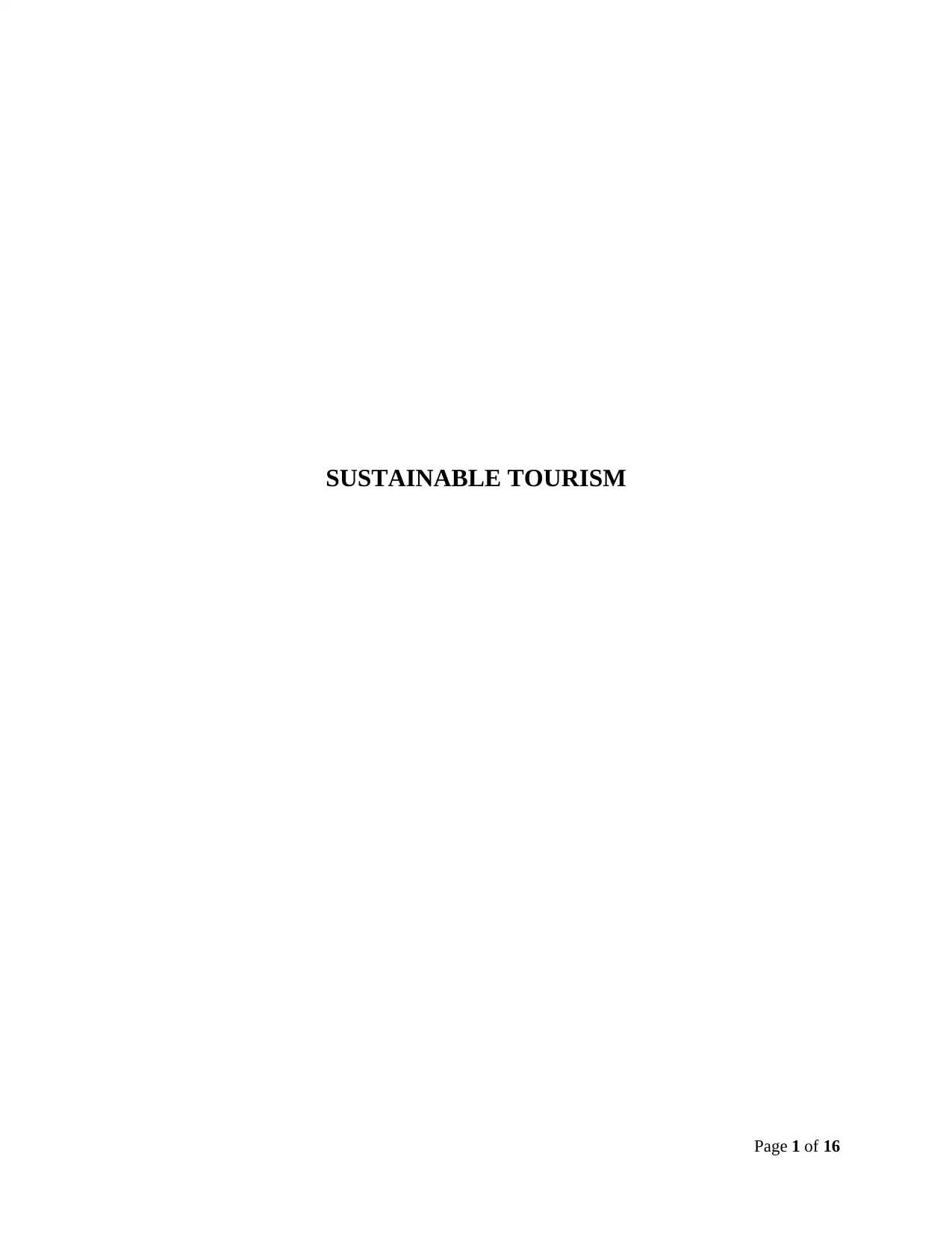
SUSTAINABLE TOURISM
Page 1 of 16
Page 1 of 16
Paraphrase This Document
Need a fresh take? Get an instant paraphrase of this document with our AI Paraphraser
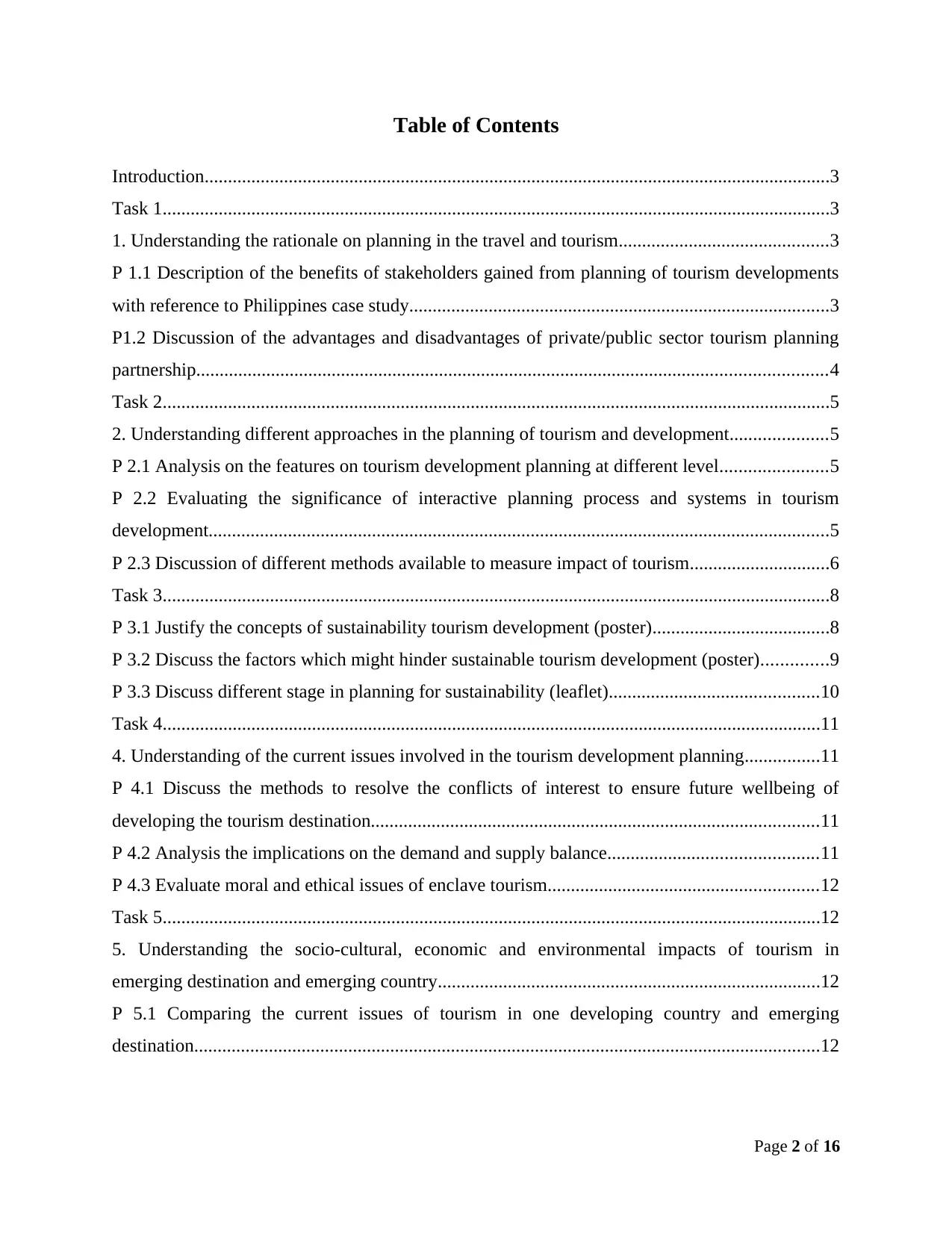
Table of Contents
Introduction......................................................................................................................................3
Task 1...............................................................................................................................................3
1. Understanding the rationale on planning in the travel and tourism.............................................3
P 1.1 Description of the benefits of stakeholders gained from planning of tourism developments
with reference to Philippines case study..........................................................................................3
P1.2 Discussion of the advantages and disadvantages of private/public sector tourism planning
partnership.......................................................................................................................................4
Task 2...............................................................................................................................................5
2. Understanding different approaches in the planning of tourism and development.....................5
P 2.1 Analysis on the features on tourism development planning at different level.......................5
P 2.2 Evaluating the significance of interactive planning process and systems in tourism
development.....................................................................................................................................5
P 2.3 Discussion of different methods available to measure impact of tourism..............................6
Task 3...............................................................................................................................................8
P 3.1 Justify the concepts of sustainability tourism development (poster)......................................8
P 3.2 Discuss the factors which might hinder sustainable tourism development (poster)..............9
P 3.3 Discuss different stage in planning for sustainability (leaflet).............................................10
Task 4.............................................................................................................................................11
4. Understanding of the current issues involved in the tourism development planning................11
P 4.1 Discuss the methods to resolve the conflicts of interest to ensure future wellbeing of
developing the tourism destination................................................................................................11
P 4.2 Analysis the implications on the demand and supply balance.............................................11
P 4.3 Evaluate moral and ethical issues of enclave tourism..........................................................12
Task 5.............................................................................................................................................12
5. Understanding the socio-cultural, economic and environmental impacts of tourism in
emerging destination and emerging country..................................................................................12
P 5.1 Comparing the current issues of tourism in one developing country and emerging
destination......................................................................................................................................12
Page 2 of 16
Introduction......................................................................................................................................3
Task 1...............................................................................................................................................3
1. Understanding the rationale on planning in the travel and tourism.............................................3
P 1.1 Description of the benefits of stakeholders gained from planning of tourism developments
with reference to Philippines case study..........................................................................................3
P1.2 Discussion of the advantages and disadvantages of private/public sector tourism planning
partnership.......................................................................................................................................4
Task 2...............................................................................................................................................5
2. Understanding different approaches in the planning of tourism and development.....................5
P 2.1 Analysis on the features on tourism development planning at different level.......................5
P 2.2 Evaluating the significance of interactive planning process and systems in tourism
development.....................................................................................................................................5
P 2.3 Discussion of different methods available to measure impact of tourism..............................6
Task 3...............................................................................................................................................8
P 3.1 Justify the concepts of sustainability tourism development (poster)......................................8
P 3.2 Discuss the factors which might hinder sustainable tourism development (poster)..............9
P 3.3 Discuss different stage in planning for sustainability (leaflet).............................................10
Task 4.............................................................................................................................................11
4. Understanding of the current issues involved in the tourism development planning................11
P 4.1 Discuss the methods to resolve the conflicts of interest to ensure future wellbeing of
developing the tourism destination................................................................................................11
P 4.2 Analysis the implications on the demand and supply balance.............................................11
P 4.3 Evaluate moral and ethical issues of enclave tourism..........................................................12
Task 5.............................................................................................................................................12
5. Understanding the socio-cultural, economic and environmental impacts of tourism in
emerging destination and emerging country..................................................................................12
P 5.1 Comparing the current issues of tourism in one developing country and emerging
destination......................................................................................................................................12
Page 2 of 16
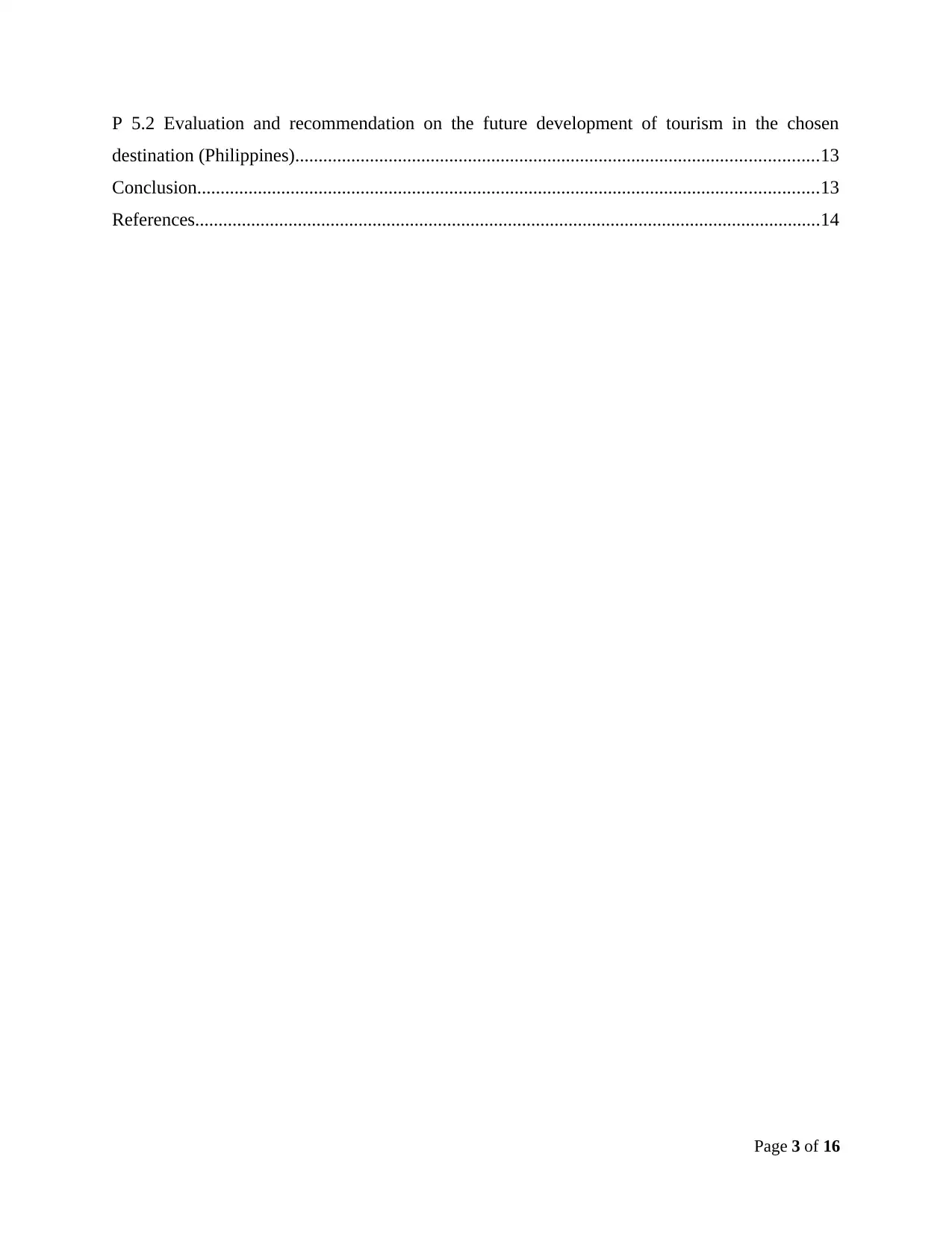
P 5.2 Evaluation and recommendation on the future development of tourism in the chosen
destination (Philippines)................................................................................................................13
Conclusion.....................................................................................................................................13
References......................................................................................................................................14
Page 3 of 16
destination (Philippines)................................................................................................................13
Conclusion.....................................................................................................................................13
References......................................................................................................................................14
Page 3 of 16
⊘ This is a preview!⊘
Do you want full access?
Subscribe today to unlock all pages.

Trusted by 1+ million students worldwide

Introduction
Tourism is an important source of income of a nation and can be put into larger process in order
to gain better returns of the development of the financial conditions of large number of local
communities as well as the nation as a whole. The modern concept of tourism and travel is
revolving around the concept of sustainable tourism that is included in the process of
development of both the nature as well as the economic state of the country. The present study
has been produced with proper consideration of the stature and functioning of Philippines on the
stature of functioning to develop sustainable tourism in the nation.
Task 1
1. Understanding the rationale on planning in the travel and tourism
P 1.1 Description of the benefits of stakeholders gained from planning of
tourism developments with reference to Philippines case study
Tourism development has been found to be associated with a number of functioning that are
favourable in enhancing the social as well as the cultural sector of a nation. Besides, the
economical sector has also been considered to be the most important criteria for including the
tourism development in the national economy. The tourism of Philippine has been taken to be as
an important aspect in order to make improvements in the sector. A large number of stakeholders
have been considered to be associated with the same. Most important among them is the general
public that are highly associated with the same. Employment can be highly empowered through
this process making it beneficial for each and every member associated with it. Therefore,
increase in the employment has been considered to be an important aspect of Philippines tourism
department through inclusion of the criteria of sustainable tourism (Harris et al. 2002). On the
other hands, the income opportunities are also considered to be scoped to increase due to such
functioning in the tourism industry of Philippines. This is further profitable to a number of sector
of functioning in the cultural sector of the country that would allow the nation to showcase the
practices and opportunities within the national stature. As a result, the development of
sustainable tourism has been developed to be an important factor that would allow equal
development in the international identity of Philippines. Besides, a large number of stakeholders
Page 4 of 16
Tourism is an important source of income of a nation and can be put into larger process in order
to gain better returns of the development of the financial conditions of large number of local
communities as well as the nation as a whole. The modern concept of tourism and travel is
revolving around the concept of sustainable tourism that is included in the process of
development of both the nature as well as the economic state of the country. The present study
has been produced with proper consideration of the stature and functioning of Philippines on the
stature of functioning to develop sustainable tourism in the nation.
Task 1
1. Understanding the rationale on planning in the travel and tourism
P 1.1 Description of the benefits of stakeholders gained from planning of
tourism developments with reference to Philippines case study
Tourism development has been found to be associated with a number of functioning that are
favourable in enhancing the social as well as the cultural sector of a nation. Besides, the
economical sector has also been considered to be the most important criteria for including the
tourism development in the national economy. The tourism of Philippine has been taken to be as
an important aspect in order to make improvements in the sector. A large number of stakeholders
have been considered to be associated with the same. Most important among them is the general
public that are highly associated with the same. Employment can be highly empowered through
this process making it beneficial for each and every member associated with it. Therefore,
increase in the employment has been considered to be an important aspect of Philippines tourism
department through inclusion of the criteria of sustainable tourism (Harris et al. 2002). On the
other hands, the income opportunities are also considered to be scoped to increase due to such
functioning in the tourism industry of Philippines. This is further profitable to a number of sector
of functioning in the cultural sector of the country that would allow the nation to showcase the
practices and opportunities within the national stature. As a result, the development of
sustainable tourism has been developed to be an important factor that would allow equal
development in the international identity of Philippines. Besides, a large number of stakeholders
Page 4 of 16
Paraphrase This Document
Need a fresh take? Get an instant paraphrase of this document with our AI Paraphraser

in both the private and the public sector has been considered to be an important stakeh0older of
the system that are likely to be benefitted by the same.
P1.2 Discussion of the advantages and disadvantages of private/public sector
tourism planning partnership
Public private Partnership
Public private Partnership represents that contractual agreement that occurs between a public
agency such as state or a local body and that of the private sector through any private entity. The
agreement is thus considered to be an important criterion for fulfilling the aims that has been
taken as an important stature to agree with sharing the skills, tools as well as asset that might be
used to deliver services or facilities to the public (Page and Connell, 2006).
Public private Partnership in Philippines
Public private Partnership can be considered to be an important step in order to fulfil the
requirements in the tourism department of the organization. Philippines has considered the
implementation of the Public private Partnership in various sectors other than the tourism sector
making the functioning easy to provide services to the public. In the stature of tourism the
country has taken it as an important structure to gain sustenance from various areas in tourism.
This implicates in providing situational importance to the prospects that might be gained for
sustainable tourism and incorporation of all the aspects of sustenance in this sector. Therefore, it
has been aimed in the nation so both the stature of gaining revenue from the tourism sector as
well as enhancing the processes of protection of the environment has been considered.
Advantages and disadvantages in Public private Partnership in Philippines
Advantages of Public private Partnership in
Philippines
Disadvantages of Public private Partnership
in Philippines
1. Boost development in both the private
and the public sector
2. Increases the employment opportunities
in both the sectors
3. Functioning within the industry would
1. The risk factors have been found to have
increased manifold in the aspects of economic
financial development
2. Budgeting becomes difficult as there is a
consideration of both the environmental factors
Page 5 of 16
the system that are likely to be benefitted by the same.
P1.2 Discussion of the advantages and disadvantages of private/public sector
tourism planning partnership
Public private Partnership
Public private Partnership represents that contractual agreement that occurs between a public
agency such as state or a local body and that of the private sector through any private entity. The
agreement is thus considered to be an important criterion for fulfilling the aims that has been
taken as an important stature to agree with sharing the skills, tools as well as asset that might be
used to deliver services or facilities to the public (Page and Connell, 2006).
Public private Partnership in Philippines
Public private Partnership can be considered to be an important step in order to fulfil the
requirements in the tourism department of the organization. Philippines has considered the
implementation of the Public private Partnership in various sectors other than the tourism sector
making the functioning easy to provide services to the public. In the stature of tourism the
country has taken it as an important structure to gain sustenance from various areas in tourism.
This implicates in providing situational importance to the prospects that might be gained for
sustainable tourism and incorporation of all the aspects of sustenance in this sector. Therefore, it
has been aimed in the nation so both the stature of gaining revenue from the tourism sector as
well as enhancing the processes of protection of the environment has been considered.
Advantages and disadvantages in Public private Partnership in Philippines
Advantages of Public private Partnership in
Philippines
Disadvantages of Public private Partnership
in Philippines
1. Boost development in both the private
and the public sector
2. Increases the employment opportunities
in both the sectors
3. Functioning within the industry would
1. The risk factors have been found to have
increased manifold in the aspects of economic
financial development
2. Budgeting becomes difficult as there is a
consideration of both the environmental factors
Page 5 of 16
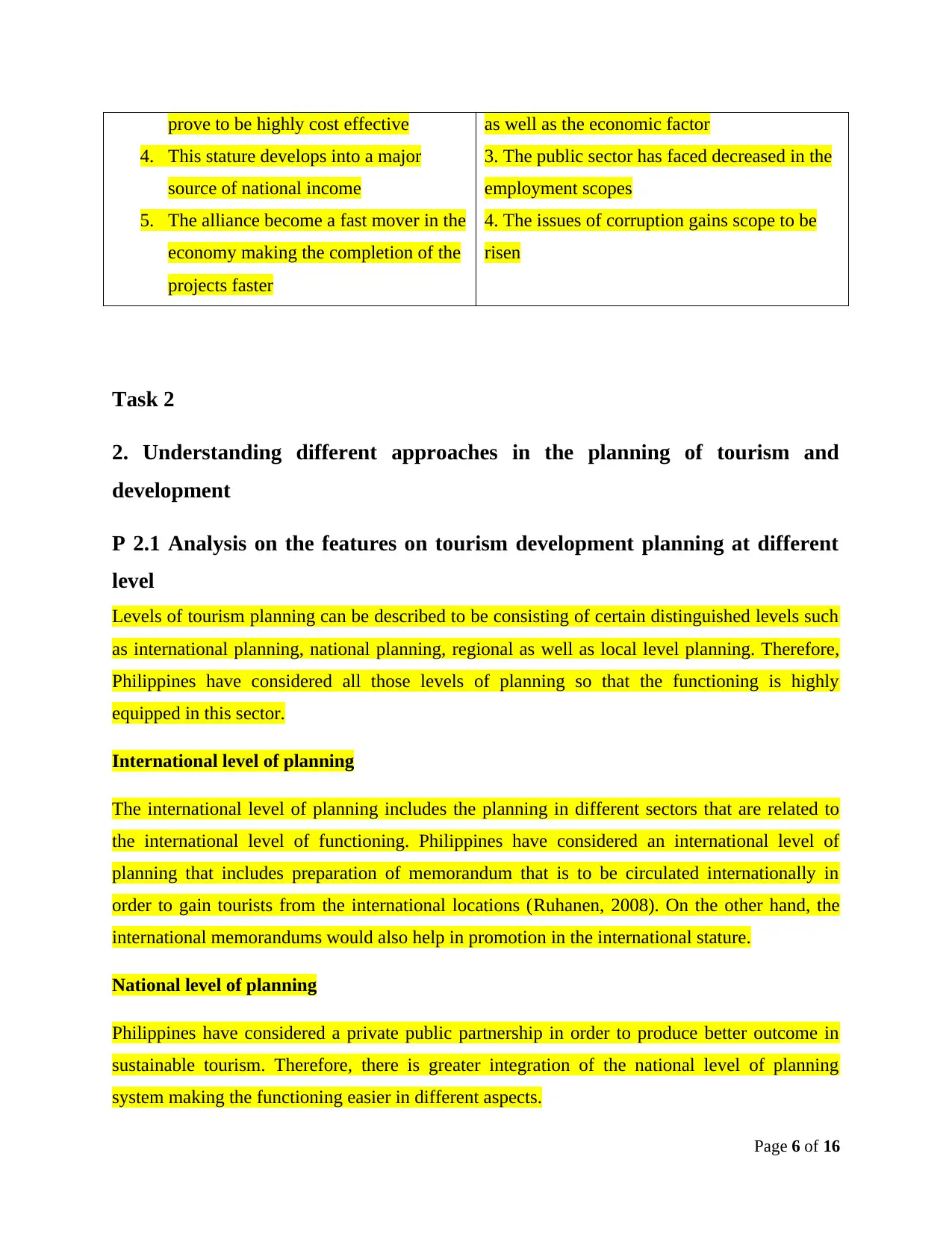
prove to be highly cost effective
4. This stature develops into a major
source of national income
5. The alliance become a fast mover in the
economy making the completion of the
projects faster
as well as the economic factor
3. The public sector has faced decreased in the
employment scopes
4. The issues of corruption gains scope to be
risen
Task 2
2. Understanding different approaches in the planning of tourism and
development
P 2.1 Analysis on the features on tourism development planning at different
level
Levels of tourism planning can be described to be consisting of certain distinguished levels such
as international planning, national planning, regional as well as local level planning. Therefore,
Philippines have considered all those levels of planning so that the functioning is highly
equipped in this sector.
International level of planning
The international level of planning includes the planning in different sectors that are related to
the international level of functioning. Philippines have considered an international level of
planning that includes preparation of memorandum that is to be circulated internationally in
order to gain tourists from the international locations (Ruhanen, 2008). On the other hand, the
international memorandums would also help in promotion in the international stature.
National level of planning
Philippines have considered a private public partnership in order to produce better outcome in
sustainable tourism. Therefore, there is greater integration of the national level of planning
system making the functioning easier in different aspects.
Page 6 of 16
4. This stature develops into a major
source of national income
5. The alliance become a fast mover in the
economy making the completion of the
projects faster
as well as the economic factor
3. The public sector has faced decreased in the
employment scopes
4. The issues of corruption gains scope to be
risen
Task 2
2. Understanding different approaches in the planning of tourism and
development
P 2.1 Analysis on the features on tourism development planning at different
level
Levels of tourism planning can be described to be consisting of certain distinguished levels such
as international planning, national planning, regional as well as local level planning. Therefore,
Philippines have considered all those levels of planning so that the functioning is highly
equipped in this sector.
International level of planning
The international level of planning includes the planning in different sectors that are related to
the international level of functioning. Philippines have considered an international level of
planning that includes preparation of memorandum that is to be circulated internationally in
order to gain tourists from the international locations (Ruhanen, 2008). On the other hand, the
international memorandums would also help in promotion in the international stature.
National level of planning
Philippines have considered a private public partnership in order to produce better outcome in
sustainable tourism. Therefore, there is greater integration of the national level of planning
system making the functioning easier in different aspects.
Page 6 of 16
⊘ This is a preview!⊘
Do you want full access?
Subscribe today to unlock all pages.

Trusted by 1+ million students worldwide
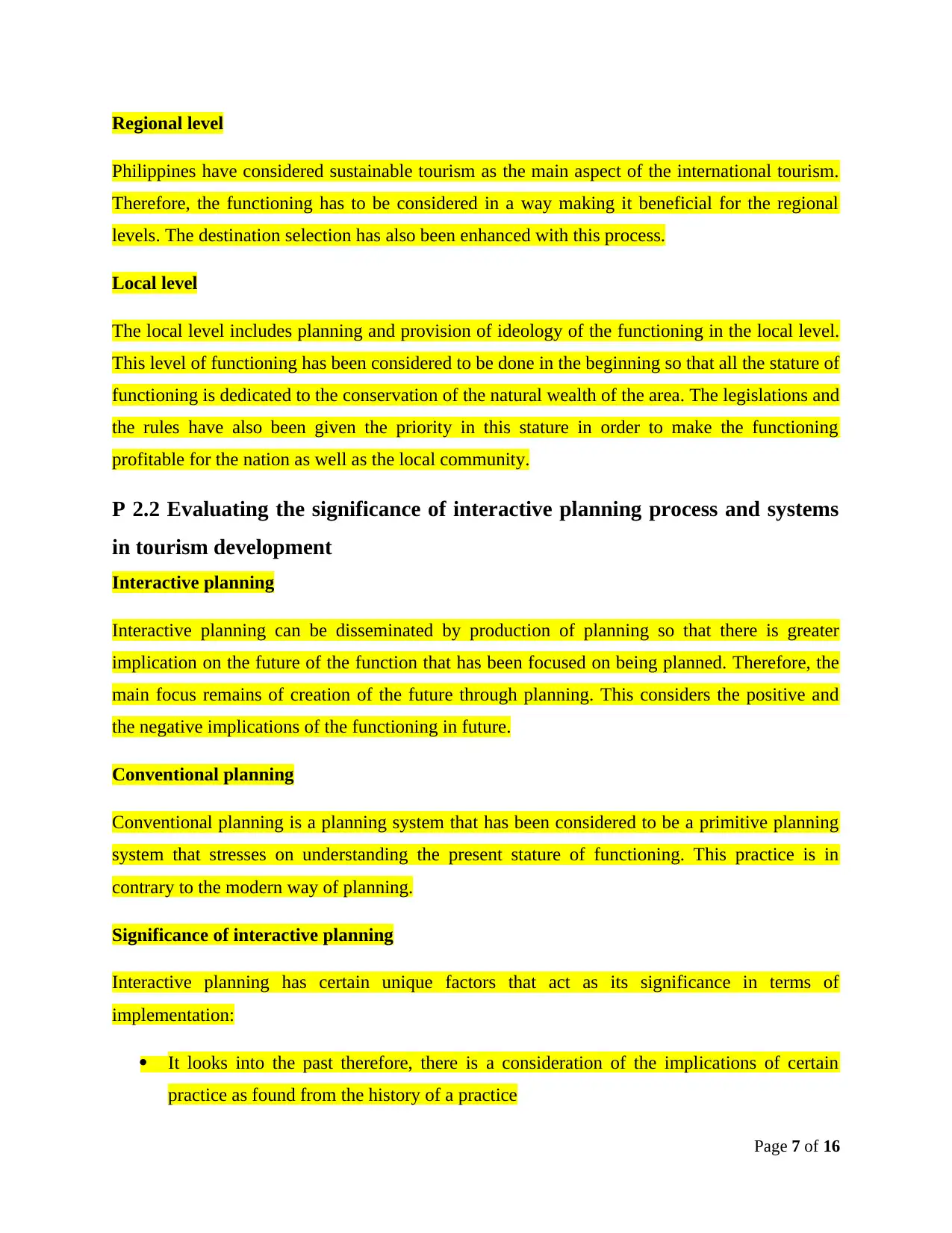
Regional level
Philippines have considered sustainable tourism as the main aspect of the international tourism.
Therefore, the functioning has to be considered in a way making it beneficial for the regional
levels. The destination selection has also been enhanced with this process.
Local level
The local level includes planning and provision of ideology of the functioning in the local level.
This level of functioning has been considered to be done in the beginning so that all the stature of
functioning is dedicated to the conservation of the natural wealth of the area. The legislations and
the rules have also been given the priority in this stature in order to make the functioning
profitable for the nation as well as the local community.
P 2.2 Evaluating the significance of interactive planning process and systems
in tourism development
Interactive planning
Interactive planning can be disseminated by production of planning so that there is greater
implication on the future of the function that has been focused on being planned. Therefore, the
main focus remains of creation of the future through planning. This considers the positive and
the negative implications of the functioning in future.
Conventional planning
Conventional planning is a planning system that has been considered to be a primitive planning
system that stresses on understanding the present stature of functioning. This practice is in
contrary to the modern way of planning.
Significance of interactive planning
Interactive planning has certain unique factors that act as its significance in terms of
implementation:
It looks into the past therefore, there is a consideration of the implications of certain
practice as found from the history of a practice
Page 7 of 16
Philippines have considered sustainable tourism as the main aspect of the international tourism.
Therefore, the functioning has to be considered in a way making it beneficial for the regional
levels. The destination selection has also been enhanced with this process.
Local level
The local level includes planning and provision of ideology of the functioning in the local level.
This level of functioning has been considered to be done in the beginning so that all the stature of
functioning is dedicated to the conservation of the natural wealth of the area. The legislations and
the rules have also been given the priority in this stature in order to make the functioning
profitable for the nation as well as the local community.
P 2.2 Evaluating the significance of interactive planning process and systems
in tourism development
Interactive planning
Interactive planning can be disseminated by production of planning so that there is greater
implication on the future of the function that has been focused on being planned. Therefore, the
main focus remains of creation of the future through planning. This considers the positive and
the negative implications of the functioning in future.
Conventional planning
Conventional planning is a planning system that has been considered to be a primitive planning
system that stresses on understanding the present stature of functioning. This practice is in
contrary to the modern way of planning.
Significance of interactive planning
Interactive planning has certain unique factors that act as its significance in terms of
implementation:
It looks into the past therefore, there is a consideration of the implications of certain
practice as found from the history of a practice
Page 7 of 16
Paraphrase This Document
Need a fresh take? Get an instant paraphrase of this document with our AI Paraphraser
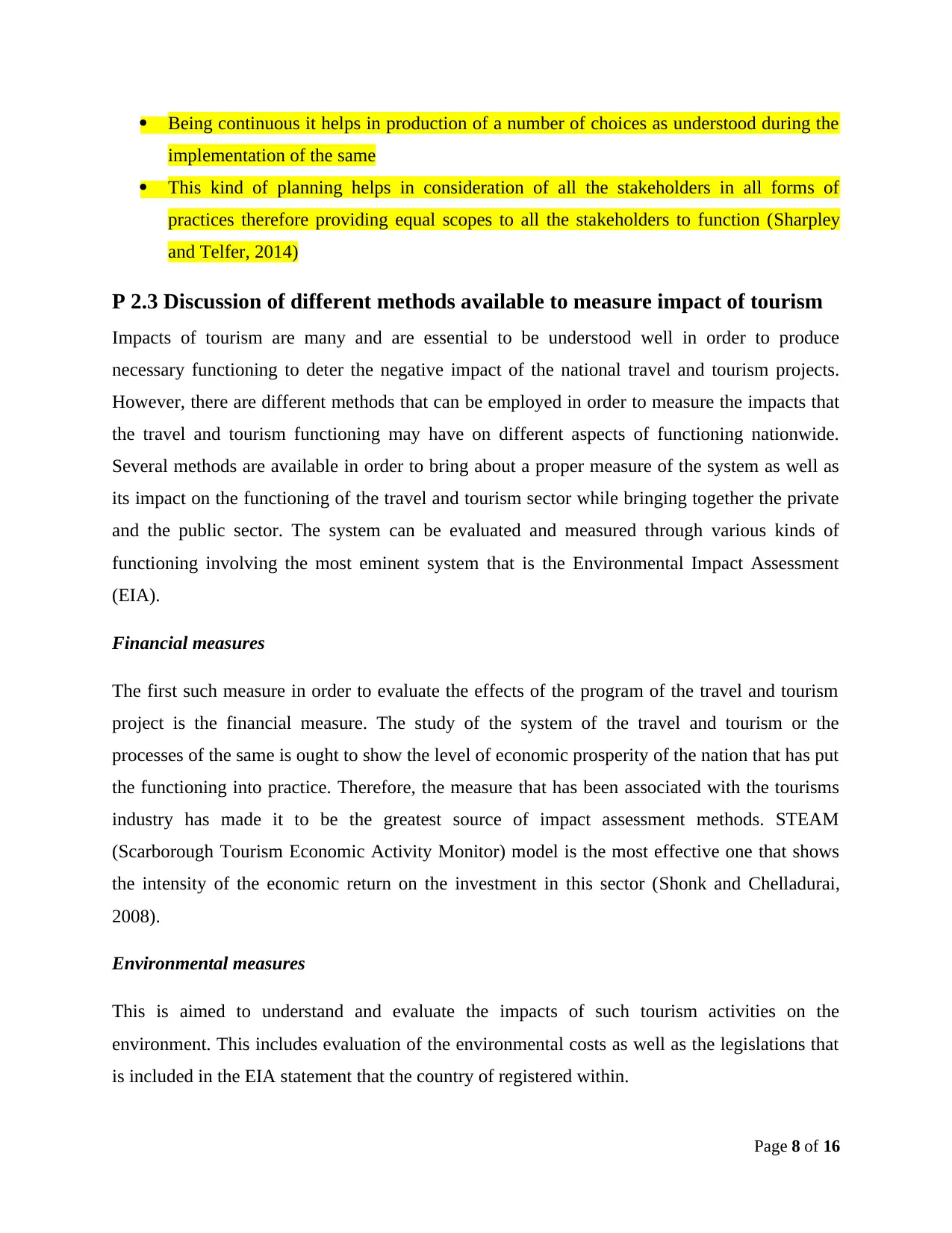
Being continuous it helps in production of a number of choices as understood during the
implementation of the same
This kind of planning helps in consideration of all the stakeholders in all forms of
practices therefore providing equal scopes to all the stakeholders to function (Sharpley
and Telfer, 2014)
P 2.3 Discussion of different methods available to measure impact of tourism
Impacts of tourism are many and are essential to be understood well in order to produce
necessary functioning to deter the negative impact of the national travel and tourism projects.
However, there are different methods that can be employed in order to measure the impacts that
the travel and tourism functioning may have on different aspects of functioning nationwide.
Several methods are available in order to bring about a proper measure of the system as well as
its impact on the functioning of the travel and tourism sector while bringing together the private
and the public sector. The system can be evaluated and measured through various kinds of
functioning involving the most eminent system that is the Environmental Impact Assessment
(EIA).
Financial measures
The first such measure in order to evaluate the effects of the program of the travel and tourism
project is the financial measure. The study of the system of the travel and tourism or the
processes of the same is ought to show the level of economic prosperity of the nation that has put
the functioning into practice. Therefore, the measure that has been associated with the tourisms
industry has made it to be the greatest source of impact assessment methods. STEAM
(Scarborough Tourism Economic Activity Monitor) model is the most effective one that shows
the intensity of the economic return on the investment in this sector (Shonk and Chelladurai,
2008).
Environmental measures
This is aimed to understand and evaluate the impacts of such tourism activities on the
environment. This includes evaluation of the environmental costs as well as the legislations that
is included in the EIA statement that the country of registered within.
Page 8 of 16
implementation of the same
This kind of planning helps in consideration of all the stakeholders in all forms of
practices therefore providing equal scopes to all the stakeholders to function (Sharpley
and Telfer, 2014)
P 2.3 Discussion of different methods available to measure impact of tourism
Impacts of tourism are many and are essential to be understood well in order to produce
necessary functioning to deter the negative impact of the national travel and tourism projects.
However, there are different methods that can be employed in order to measure the impacts that
the travel and tourism functioning may have on different aspects of functioning nationwide.
Several methods are available in order to bring about a proper measure of the system as well as
its impact on the functioning of the travel and tourism sector while bringing together the private
and the public sector. The system can be evaluated and measured through various kinds of
functioning involving the most eminent system that is the Environmental Impact Assessment
(EIA).
Financial measures
The first such measure in order to evaluate the effects of the program of the travel and tourism
project is the financial measure. The study of the system of the travel and tourism or the
processes of the same is ought to show the level of economic prosperity of the nation that has put
the functioning into practice. Therefore, the measure that has been associated with the tourisms
industry has made it to be the greatest source of impact assessment methods. STEAM
(Scarborough Tourism Economic Activity Monitor) model is the most effective one that shows
the intensity of the economic return on the investment in this sector (Shonk and Chelladurai,
2008).
Environmental measures
This is aimed to understand and evaluate the impacts of such tourism activities on the
environment. This includes evaluation of the environmental costs as well as the legislations that
is included in the EIA statement that the country of registered within.
Page 8 of 16

Social measures
It talks about the socio-economic impacts of the functioning within the travel and tourisms
sector. It describes the impact on the investment as well as the intensity of the developmental
plan to increase return on the investments in this sector. There is a nominal need to have a survey
that would include the analysis of the secondary that has been acquired through inspection of the
public ideology along with the assessment of the public documents and records made over time.
Page 9 of 16
It talks about the socio-economic impacts of the functioning within the travel and tourisms
sector. It describes the impact on the investment as well as the intensity of the developmental
plan to increase return on the investments in this sector. There is a nominal need to have a survey
that would include the analysis of the secondary that has been acquired through inspection of the
public ideology along with the assessment of the public documents and records made over time.
Page 9 of 16
⊘ This is a preview!⊘
Do you want full access?
Subscribe today to unlock all pages.

Trusted by 1+ million students worldwide
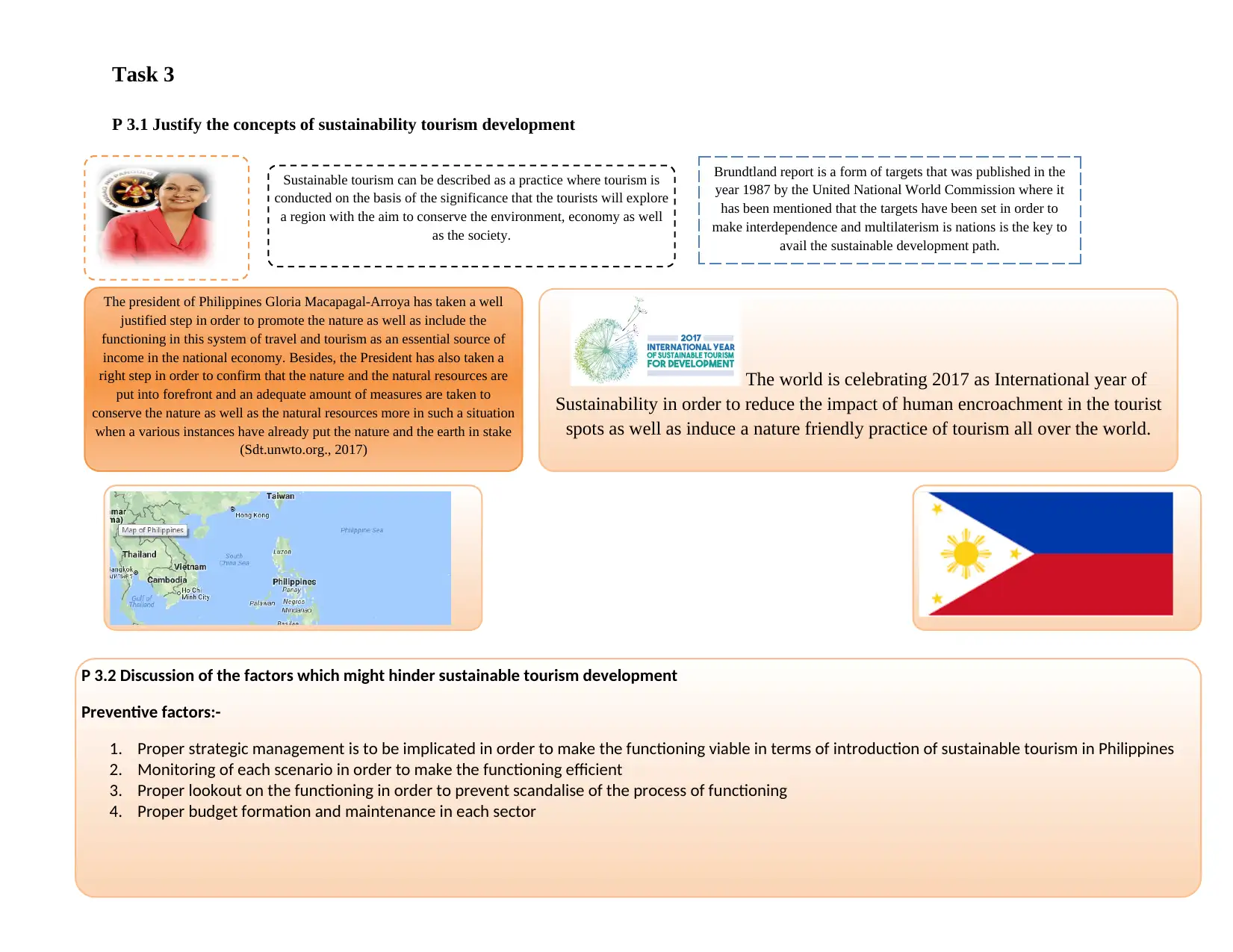
Task 3
P 3.1 Justify the concepts of sustainability tourism development
.
Page 10 of 16
The president of Philippines Gloria Macapagal-Arroya has taken a well
justified step in order to promote the nature as well as include the
functioning in this system of travel and tourism as an essential source of
income in the national economy. Besides, the President has also taken a
right step in order to confirm that the nature and the natural resources are
put into forefront and an adequate amount of measures are taken to
conserve the nature as well as the natural resources more in such a situation
when a various instances have already put the nature and the earth in stake
(Sdt.unwto.org., 2017)
Sustainable tourism can be described as a practice where tourism is
conducted on the basis of the significance that the tourists will explore
a region with the aim to conserve the environment, economy as well
as the society.
Brundtland report is a form of targets that was published in the
year 1987 by the United National World Commission where it
has been mentioned that the targets have been set in order to
make interdependence and multilaterism is nations is the key to
avail the sustainable development path.
The world is celebrating 2017 as International year of
Sustainability in order to reduce the impact of human encroachment in the tourist
spots as well as induce a nature friendly practice of tourism all over the world.
P 3.2 Discussion of the factors which might hinder sustainable tourism development
Preventive factors:-
1. Proper strategic management is to be implicated in order to make the functioning viable in terms of introduction of sustainable tourism in Philippines
2. Monitoring of each scenario in order to make the functioning efficient
3. Proper lookout on the functioning in order to prevent scandalise of the process of functioning
4. Proper budget formation and maintenance in each sector
P 3.1 Justify the concepts of sustainability tourism development
.
Page 10 of 16
The president of Philippines Gloria Macapagal-Arroya has taken a well
justified step in order to promote the nature as well as include the
functioning in this system of travel and tourism as an essential source of
income in the national economy. Besides, the President has also taken a
right step in order to confirm that the nature and the natural resources are
put into forefront and an adequate amount of measures are taken to
conserve the nature as well as the natural resources more in such a situation
when a various instances have already put the nature and the earth in stake
(Sdt.unwto.org., 2017)
Sustainable tourism can be described as a practice where tourism is
conducted on the basis of the significance that the tourists will explore
a region with the aim to conserve the environment, economy as well
as the society.
Brundtland report is a form of targets that was published in the
year 1987 by the United National World Commission where it
has been mentioned that the targets have been set in order to
make interdependence and multilaterism is nations is the key to
avail the sustainable development path.
The world is celebrating 2017 as International year of
Sustainability in order to reduce the impact of human encroachment in the tourist
spots as well as induce a nature friendly practice of tourism all over the world.
P 3.2 Discussion of the factors which might hinder sustainable tourism development
Preventive factors:-
1. Proper strategic management is to be implicated in order to make the functioning viable in terms of introduction of sustainable tourism in Philippines
2. Monitoring of each scenario in order to make the functioning efficient
3. Proper lookout on the functioning in order to prevent scandalise of the process of functioning
4. Proper budget formation and maintenance in each sector
Paraphrase This Document
Need a fresh take? Get an instant paraphrase of this document with our AI Paraphraser
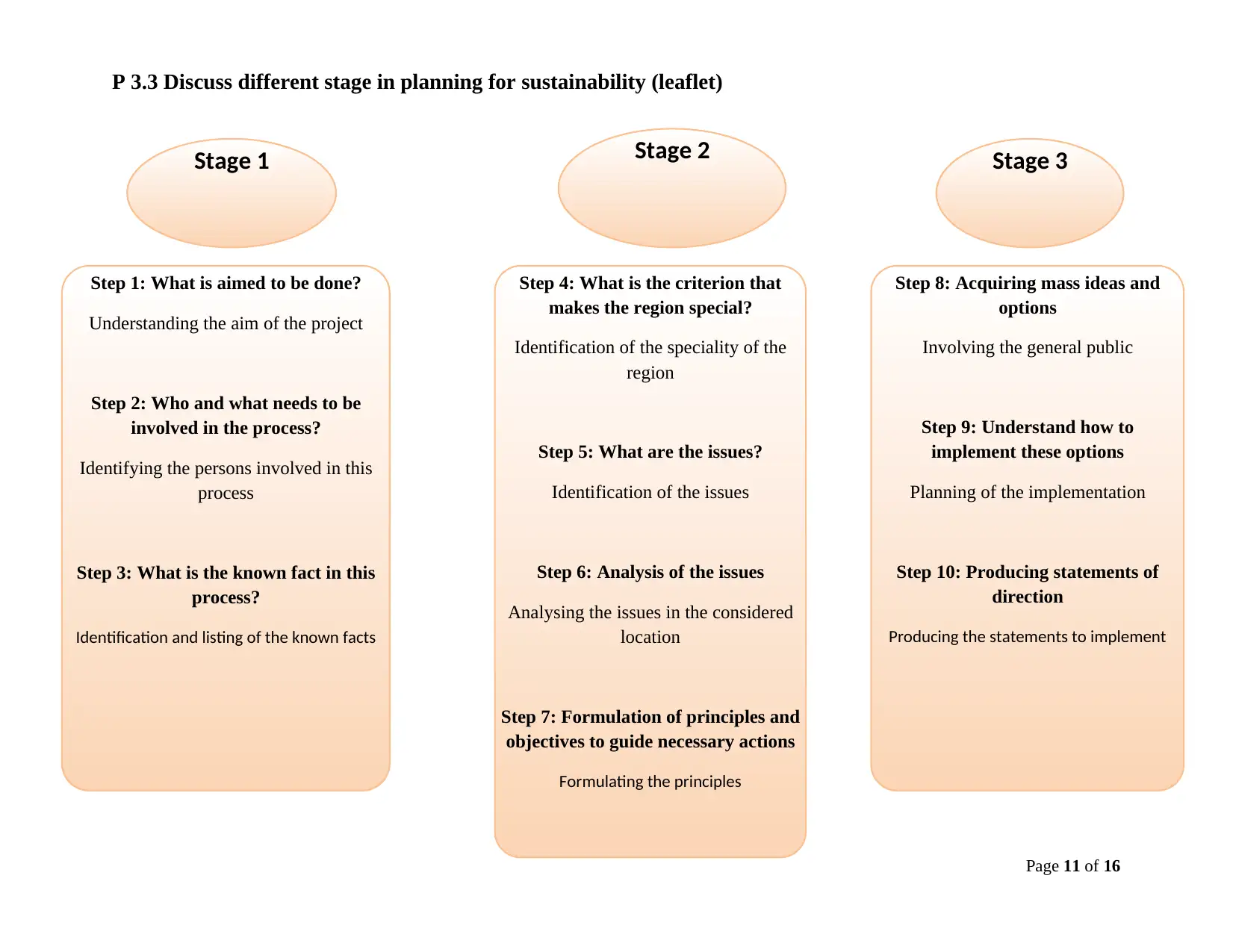
P 3.3 Discuss different stage in planning for sustainability (leaflet)
Page 11 of 16
Stage 1
Step 1: What is aimed to be done?
Understanding the aim of the project
Step 2: Who and what needs to be
involved in the process?
Identifying the persons involved in this
process
Step 3: What is the known fact in this
process?
Identification and listing of the known facts
Stage 2
Step 4: What is the criterion that
makes the region special?
Identification of the speciality of the
region
Step 5: What are the issues?
Identification of the issues
Step 6: Analysis of the issues
Analysing the issues in the considered
location
Step 7: Formulation of principles and
objectives to guide necessary actions
Formulating the principles
Stage 3
Step 8: Acquiring mass ideas and
options
Involving the general public
Step 9: Understand how to
implement these options
Planning of the implementation
Step 10: Producing statements of
direction
Producing the statements to implement
Page 11 of 16
Stage 1
Step 1: What is aimed to be done?
Understanding the aim of the project
Step 2: Who and what needs to be
involved in the process?
Identifying the persons involved in this
process
Step 3: What is the known fact in this
process?
Identification and listing of the known facts
Stage 2
Step 4: What is the criterion that
makes the region special?
Identification of the speciality of the
region
Step 5: What are the issues?
Identification of the issues
Step 6: Analysis of the issues
Analysing the issues in the considered
location
Step 7: Formulation of principles and
objectives to guide necessary actions
Formulating the principles
Stage 3
Step 8: Acquiring mass ideas and
options
Involving the general public
Step 9: Understand how to
implement these options
Planning of the implementation
Step 10: Producing statements of
direction
Producing the statements to implement
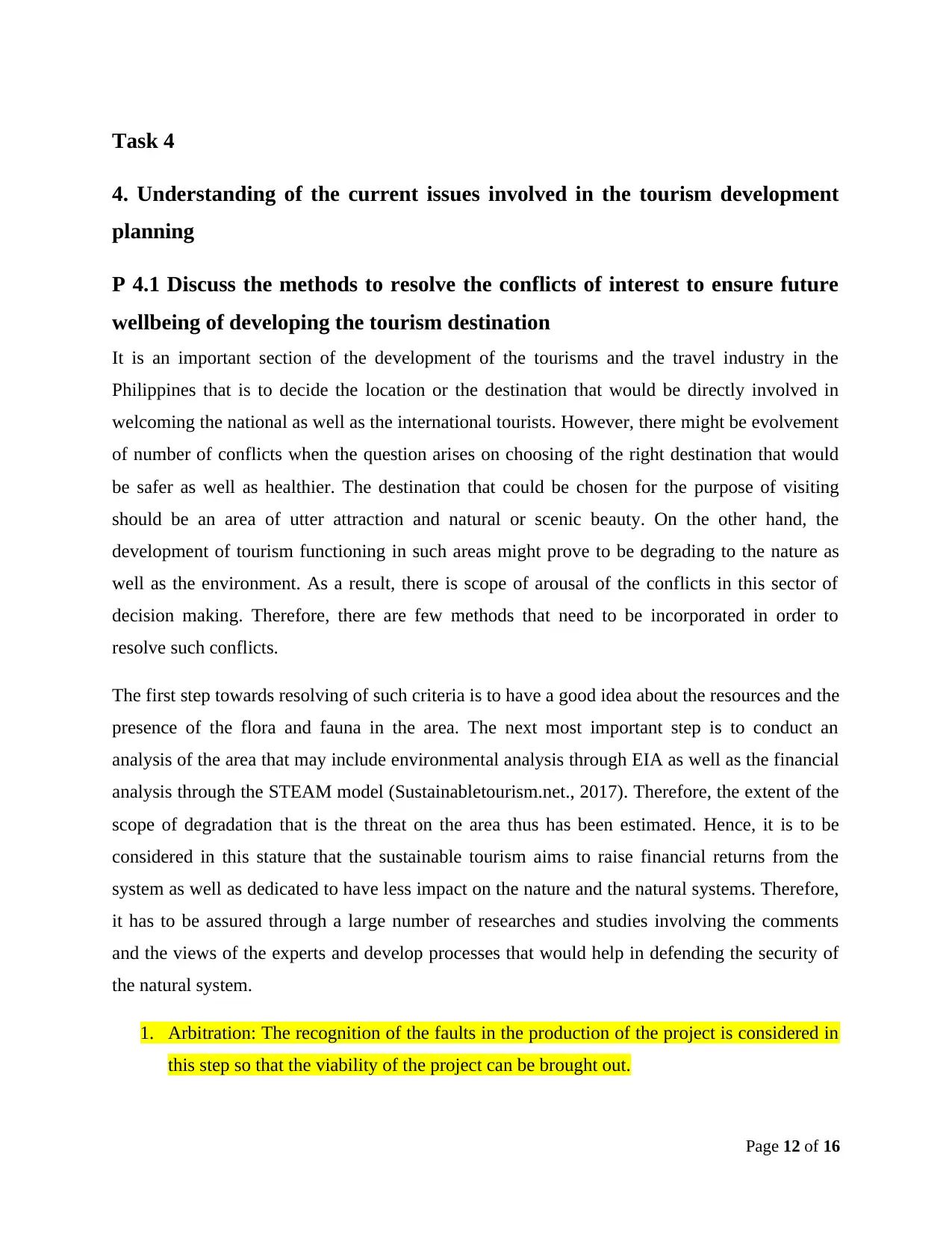
Task 4
4. Understanding of the current issues involved in the tourism development
planning
P 4.1 Discuss the methods to resolve the conflicts of interest to ensure future
wellbeing of developing the tourism destination
It is an important section of the development of the tourisms and the travel industry in the
Philippines that is to decide the location or the destination that would be directly involved in
welcoming the national as well as the international tourists. However, there might be evolvement
of number of conflicts when the question arises on choosing of the right destination that would
be safer as well as healthier. The destination that could be chosen for the purpose of visiting
should be an area of utter attraction and natural or scenic beauty. On the other hand, the
development of tourism functioning in such areas might prove to be degrading to the nature as
well as the environment. As a result, there is scope of arousal of the conflicts in this sector of
decision making. Therefore, there are few methods that need to be incorporated in order to
resolve such conflicts.
The first step towards resolving of such criteria is to have a good idea about the resources and the
presence of the flora and fauna in the area. The next most important step is to conduct an
analysis of the area that may include environmental analysis through EIA as well as the financial
analysis through the STEAM model (Sustainabletourism.net., 2017). Therefore, the extent of the
scope of degradation that is the threat on the area thus has been estimated. Hence, it is to be
considered in this stature that the sustainable tourism aims to raise financial returns from the
system as well as dedicated to have less impact on the nature and the natural systems. Therefore,
it has to be assured through a large number of researches and studies involving the comments
and the views of the experts and develop processes that would help in defending the security of
the natural system.
1. Arbitration: The recognition of the faults in the production of the project is considered in
this step so that the viability of the project can be brought out.
Page 12 of 16
4. Understanding of the current issues involved in the tourism development
planning
P 4.1 Discuss the methods to resolve the conflicts of interest to ensure future
wellbeing of developing the tourism destination
It is an important section of the development of the tourisms and the travel industry in the
Philippines that is to decide the location or the destination that would be directly involved in
welcoming the national as well as the international tourists. However, there might be evolvement
of number of conflicts when the question arises on choosing of the right destination that would
be safer as well as healthier. The destination that could be chosen for the purpose of visiting
should be an area of utter attraction and natural or scenic beauty. On the other hand, the
development of tourism functioning in such areas might prove to be degrading to the nature as
well as the environment. As a result, there is scope of arousal of the conflicts in this sector of
decision making. Therefore, there are few methods that need to be incorporated in order to
resolve such conflicts.
The first step towards resolving of such criteria is to have a good idea about the resources and the
presence of the flora and fauna in the area. The next most important step is to conduct an
analysis of the area that may include environmental analysis through EIA as well as the financial
analysis through the STEAM model (Sustainabletourism.net., 2017). Therefore, the extent of the
scope of degradation that is the threat on the area thus has been estimated. Hence, it is to be
considered in this stature that the sustainable tourism aims to raise financial returns from the
system as well as dedicated to have less impact on the nature and the natural systems. Therefore,
it has to be assured through a large number of researches and studies involving the comments
and the views of the experts and develop processes that would help in defending the security of
the natural system.
1. Arbitration: The recognition of the faults in the production of the project is considered in
this step so that the viability of the project can be brought out.
Page 12 of 16
⊘ This is a preview!⊘
Do you want full access?
Subscribe today to unlock all pages.

Trusted by 1+ million students worldwide
1 out of 16
Related Documents
Your All-in-One AI-Powered Toolkit for Academic Success.
+13062052269
info@desklib.com
Available 24*7 on WhatsApp / Email
![[object Object]](/_next/static/media/star-bottom.7253800d.svg)
Unlock your academic potential
Copyright © 2020–2025 A2Z Services. All Rights Reserved. Developed and managed by ZUCOL.





